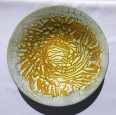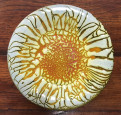Victor Lucas ( - )
Born on 24 August 1897 in Saint James (Manche), he grew up in Vire where his father had a stone-cutting business. Encouraged by his drawing teacher, he successfully attempted the entrance exam to the Sèvres School of Ceramics. Victor Lucas thus benefited from a very advanced artistic training and then from a high quality technical education. In July 1922, he obtained his diploma as a ceramic engineer and immediately started looking for his first job.
Jules Henriot, who wanted to modernise his Manufacture d'Art Breton in Quimper, accepted his application. The economic context was particularly favourable with the real start of the tourist boom in the region. However, this increasingly flourishing market was being contested by a competing earthenware manufacturer, the company Jules Verlingue, Bolloré & Cie. In this real economic war, called the "Jules war", the two factories are in a constant battle. However, this fierce competition had some positive aspects. First of all, it was a competition on a technical level that allowed Victor Lucas to modernise the production tool. Secondly, it had a stimulating effect on the artistic level, as the inter-war period was the second high point of Quimper ceramic creation after the success of Alfred Beau's productions and the first Breton decorations at the end of the 19th century. Many artists frequented the two faience factories at this time, each of which had its own outstanding figures: René Quillivic (1879-1969) at HB, Mathurin Méheut (1882-1958) at Henriot. The great International Exhibitions in Paris encouraged the two factories to excel. The 1925 exhibition honoured them with numerous prizes and contributed to the revelation of the "Seiz-Breur" group, which aimed to renew Breton art by combining tradition and modernity. Their fight against the "biniouserie" found a favourable echo with Victor Lucas. On the other hand, advocating the universality of art, he was critical of their concept of specifically Breton art and did not follow them in their nationalist claims.
At the end of March 1941, he left Henriot for HB and, despite the difficult situation of the war, fully assumed his function as technical director. In May 1944, the end of hostilities finally opened up prospects for the future, and Victor Lucas resigned, with the idea of carrying out his great project, the culmination of his engineering career: creating his own Kéraluc factory.

